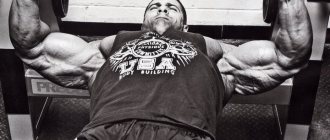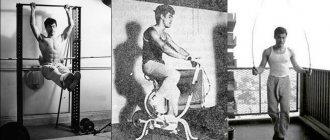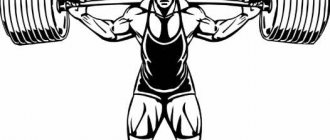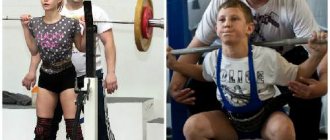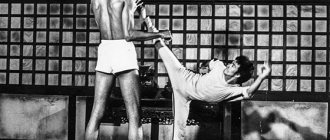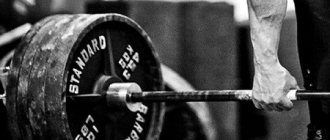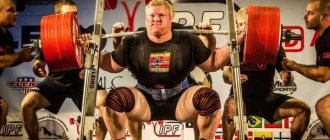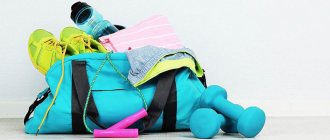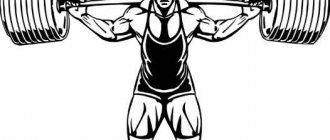The strength and mass training program is a modification of the popular program from B.I. Sheiko is considered one of the best, if not the best! Training according to the program is complex and requires complete recovery and the highest quality diet; in addition, such systems are difficult to understand, which greatly limits the range of users. I'm sure many have seen how fast powerlifters develop under the supervision of good trainers, while bodybuilders try to get to steroids. The whole secret is in the given technique. Despite the fact that the goal of the program is strength, muscle mass grows quite well for absolutely everyone, the main increase occurs due to an increase in the shoulder girdle and legs.
The physiological meaning of the program is to perform a large number of “lifts” with significant weight, while avoiding overtraining (limited failures).
Peculiarities:
- the load is strictly dosed;
- the number of exercises is minimal;
- the number of “lifts” is large;
- restrictions for ectomorphs;
- 3 workouts per week (2 are allowed).
Now about the training itself.
The table below shows the exercises, sets, weight (% of RM) and number of repetitions. You should perform the required number of approaches with the required weight; “extra” repetitions, even with excess strength, are not performed!
The weight of the weights is calculated as a percentage of the one-time maximum (RM). RM is a weight that you can lift/shake just once.
PM can be determined in 2 ways:
1. Making a penetration. But this is not always an acceptable method, as it puts a lot of stress on the body.
2. Calculation method. RM is determined based on previous training experience using a weight calculator.
Once the one-time maximum has been determined, to simplify training, you need to create a table of % weights (example below) and select the weight for training based on these data.
POWERLIFTING. FROM BEGINNER TO MASTER
In mid-2013, the book by B.I. was published. Sheiko, P.S. Goruleva, E.R. Rumyantseva, R.A. Tsedova Powerlifting. From beginner to master. The book contains 8 chapters, a list of references and applications. The foreword to the book was written by Gaston Parages, President of the IPF.
First chapter. History of the development of powerlifting
(authors B.I. Sheiko, P.S. Gorulev)
The chapter tells about the history of the emergence of powerlifting in the world, in Europe and Russia. The chapter is very well illustrated. It also contains information on the distribution of prizes in the team competition at the world championships and the evolution of weight categories. Photos of Honored Masters of Sports of Russia are shown.
Second chapter. Basic concepts and terms
(authors B.I. Sheiko, P.S. Gorulev).
The chapter provides basic concepts and terms used in powerlifting.
Third chapter. Classification of physical exercises
(author B.I. Sheiko)
The chapter provides a classification of competitive and qualifying exercises. The chapter is equipped with a large number of diagrams and illustrations of performing basic and introductory exercises. The focus of each exercise is described (for which muscle groups it is intended).
Chapter four. Physiological characteristics of power sports
(authors E.R. Rumyantseva (clauses 4.1-4.9), B.I. Sheiko (clause 4.10)
The chapter discusses the processes of adaptation of the athlete's body to physical activity of a strength nature. Issues of adaptation of the nervous, cardiovascular and respiratory systems, and the blood system are covered. Separate paragraphs are devoted to the role of hormones in adaptation to intense physical activity; fatigue and recovery processes, physique and muscular system. Section 4.10 analyzes the work of the main muscle groups when performing competitive exercises.
Fifth chapter. Basic concepts of biomechanics and technique in powerlifting
(author B.I. Sheiko)
This chapter presents the results of a biomechanical analysis of the performance of competitive exercises based on the VideoMotion hardware and software complex. The technique of the strongest athletes in the world is analyzed: Konstantin Pavlov, Evgeniy Kovalkov (squats with a barbell on the shoulders); Yulia Chistyakova, Alexandra Babina (bench press on a horizontal bench); Yuri Fedorenko, Andrey Belyaev, Maxim Baruzdin, Valeria Shcheglova (barbell deadlift). The chapter contains many illustrations and contains a large number of biomechanical parameters.
Chapter six. Methods of teaching the technique of competitive exercises
(author B.I. Sheiko)
In this chapter, along with a description of the general principles of training, a description of the basics of teaching the technique of competitive exercises is given. The sequence of training, auxiliary exercises, and errors in the technique of performing competitive exercises are given. The chapter is supplied with a large number of diagrams and illustrations.
Seventh chapter. Equipment used in powerlifting
(author B.I. Sheiko)
The chapter describes the equipment necessary to perform each of the competitive exercises. Requirements for equipment are given. A comparative description of equipment produced by various companies is given.
Eighth chapter. Powerlifting Training Planning
(author B.I. Sheiko)
The chapter begins with a historical look at the scientific research surrounding muscle strength training. A comparative analysis of training methods of foreign and Russian powerlifting specialists and methods of developing muscle strength is given. A separate paragraph is devoted to the construction of training sessions in powerlifting. An approximate training program is given depending on the training period.
Ninth chapter. Educational and training programs for athletes of different levels of preparedness
(author B.I. Sheiko)
This chapter provides training programs depending on the level of preparedness of the athletes and the preparation period. The plans and original training programs of honored trainers of Russia and Ukraine are presented: B.I. Sheiko, A.N. Fomina, A.S. Dekhanova, G.V. Khodosevich, V.S. Naleykina, L.V. Kotenzhi, A.P. Kotlubey in preparing the strongest athletes in Europe and the world: Svetlana Tesleva, Alexander Molina, Andrey Belyaev, Andrey Sivokon, Oleksiy Solovyov, Vitaly Papazov for the world championships.
Chapter ten. Sports nutrition for powerlifting
(author R.A. Tsedov)
Sports nutrition for public events and elite sports is considered. Particular attention is paid to finished products and ready-made protein mixtures, vitamin-mineral complexes, energy products, and special products for fat burning. Experimental results of using a number of products are presented.
Literature
The bibliography includes 387 literary sources (292 in Russian and 95 in English), and links to electronic resources are provided.
Applications
The appendices list the winners of the Russian and world championships in the team competition.
Summary
Monograph “Powerlifting. From beginner to master”, in terms of volume, depth of coverage, and quality of presentation, is an encyclopedia of modern powerlifting . Thanks to extensive reviews, as well as the results of our own research and experiments, this monograph contains all the most advanced that powerlifting specialists in the world have accumulated. It will be useful for both beginners and high-level athletes. It can be used not only by powerlifters, but also by all athletes involved in athletic sports. This monograph can also serve as an excellent guide for coaches and teachers of physical education universities.
I highly recommend reading this monograph. I have no doubt you will never regret it.
Sheiko's book. Powerlifting from beginner to master
BOOK “POWERLIFTING” by B.I. SHEIKO – DESCRIPTION
The monograph “Powerlifting - from beginner to master” was prepared by the authors in accordance with the powerlifting program.
It outlines the foundations of modern theory and methodology of powerlifting, and provides a modern systematic approach to improving and teaching the technique of performing competitive exercises in powerlifting. This monograph was written for coaches, athletes and powerlifting fans. Author: B.I. Sheiko, 2013.
Content
Preface Introduction
Chapter 1. HISTORY OF POWERLIFTING DEVELOPMENT
1.1. History of the development of world powerlifting (IPF) 1.1.1. Evolution of weight categories in men's and women's world championships 1.1.2. Determination of the absolute winners 1.2. History of the development of European powerlifting (EPF) 1.3. Athleticism in pre-revolutionary Russia (1885-1916) 1.4. The emergence and development of powerlifting in the USSR and Russia (1962-2012) 1.4.1. Evolution of weight categories in Russia
Chapter 2. BASIC CONCEPTS AND TERMS
2.1 Terminology used in powerlifting
Chapter 3. CLASSIFICATION OF PHYSICAL EXERCISES IN POWERLIFTING
3.1. Historical background 3.2. Principles of classification of physical exercises 3.3. Classification of basic and additional exercises 3.4. Exercises for squats with a barbell on the shoulders 3.5. Bench press exercises 3.6. Deadlift Exercises
Chapter 4. PHYSIOLOGICAL CHARACTERISTICS OF STRENGTH SPORTS
4.1. Adaptation of the body to physical activity 4.2. Nervous system 4.3. Cardiovascular and respiratory system 4.4. Blood system 4.5. Energy exchange 4.6. Excretory functions 4.7. The role of hormones in the body’s adaptation to intense physical activity 4.8. Fatigue and recovery processes 4.9. Physique and muscular system 4.10. Participation of muscles in performing competitive exercises 4.10.1. Work of the main muscle groups when performing squats 4.10.2. Work of the main muscle groups when performing the bench press 4.10.3. The work of the main muscle groups when performing deadlifts
Chapter 5. BASIC CONCEPTS OF BIOMECHANICS AND TECHNIQUES IN POWERLIFTING
5.1. Technical structure of competitive exercises 5.1.1. Period and phase structure of exercise 5.2. Biomechanical video analysis of the complex of movements of athletes in powerlifting 5.2.1. Hardware and software complex for biomechanical analysis of motor actions of powerlifters 5.3. Squatting technique with a barbell on the shoulders 5.3.1. Rules and procedure for performing squats 5.3.2. Phase structure of squats 5.3.3. Technique and motor structure of squats 5.3.4. Squat technique for athletes of the highest sportsmanship 5.3.4.1. Technical features of K. Pavlov’s squats 5.3.4.2. Technical features of E. Kovalkov’s squats 5.4. Bench press technique on a horizontal bench 5.4.1. Rules and procedure for performing the bench press 5.4.2. Phase structure of the bench press technique 5.4.3. Technique and motor structure of the bench press 5.4.4. Biomechanical analysis of bench press technique 5.4.5. Bench press technique for athletes of the highest sports skill 5.4.5.1. Technical features of K. Pavlov’s bench press 5.4.5.2. Technical features of the bench press by Yu. Chistyakova 5.5. Technique for performing deadlifts 5.5.1. Rules and procedure for performing deadlifts 5.5.2. Phase structure of traction technique 5.5.3. Technique and motor structure of traction 5.5.4. Comparative analysis of deadlift styles 5.5.5. Technique for performing deadlifts by athletes of the highest sportsmanship 5.5.5.1. Features of A. Belyaev’s traction technique 5.5.5.2. Features of V. Shcheglova’s traction technique 5.5.5.3. Features of M. Baruzdin's traction technique
Chapter 6. METHODOLOGY FOR TEACHING TECHNIQUES OF COMPETITIVE EXERCISES
6.1. General principles of training 6.2. Teaching methods 6.3. Formation of motor skills and abilities 6.4. Structure of teaching motor actions 6.5. Basics of teaching the technique of competitive exercises 6.5.1. Teaching the technique of squatting with a barbell on the shoulders 6.5.2. Errors in squatting technique and reasons why the lifted weight is not counted 6.5.3. Teaching the bench press technique 6.5.4. Teaching the bench press technique with a “bridge” 6.5.5. Errors in bench press technique and reasons why the weight lifted is not counted 6.5.6. Traction technique training 6.5.7. Errors in deadlift technique and reasons why the weight lifted does not count.
Chapter 7. EQUIPMENT USED IN POWERLIFTING
7.1. Equipment for squats with a barbell on the shoulders 7.2. Bench press equipment 7.3. Deadlift Equipment
Chapter 8. PLANNING TRAINING IN POWERLIFTING
8.1. The first scientific works in the field of muscle strength training 8.1.1. Training methods for Russian and foreign powerlifting specialists 8.2. Improving methods for developing muscle strength in the training process 8.3. Construction of training sessions in powerlifting 8.3.1. Construction of a separate training session and microcycles 8.3.2. Distribution of training loads across weekly cycles and training sessions 8.3.3. Construction of training in medium cycles (mesocycles) 8.3.4. Construction of training in large cycles (macrocycles) 8.3.5. Principles of long-term (long-term) planning 8.4. Volume and intensity in planning training load 8.5. Distribution of load volume by intensity zones
Chapter 9. Approximate training programs for athletes of different levels of preparedness
9.1. Sample training programs for athletes of the initial training group 9.2. Sample training programs for athletes of the training group 9.3. Sample training programs for athletes of the sports improvement group 9.4. Approximate training programs for athletes of the group of highest sportsmanship 9.5. Training plans of Ukrainian world and European champions
Chapter 10. Sports nutrition for powerlifting (R.A. Tsedov)
10.1. Healthy lifestyle and sports 10.2. Mass (amateur sports), elite sports, professional sports 10.3. Sports nutrition 10.3.1. Sports nutrition for mass sports and recreational events 10.3.2. Sports nutrition for elite sports 10.3.3. Balanced nutrition for an athlete 10.3.4. Ingredients 10.4. Finished products 10.4.1. High protein foods (proteins) 10.4.2. Protein-carbohydrate products (gainers) 10.4.3. Vitamins 10.4.4. Minerals 10.4.5. Amino acid kits 10.4.6. Energy sports nutrition products 10.4.7. Adaptogens 10.4.8. Creatine 10.4.9. Special products for fat burning 10.4.10. Products for joints 10.5. Sports nutrition is an integral part of the training process 10.6. General approach to choosing sports nutrition 10.7. Features of the use of certain types of sports nutrition 10.8. “Sports disease” or “overtraining syndrome” Literature (for Chapter 10)
Appendix Literature
Introduction
Powerlifting is a new sport that appeared abroad only in the late 40s - early 50s of the XX century, came to Russia even later, and is currently developing dynamically all over the world.
The monograph “Powerlifting” summarizes the experience of recent scientific research, both in Russia and abroad, reflects the most important aspects of the history, theory and methodology of powerlifting, and also presents modern concepts of building sports training.
The material in the monograph is presented in a strict logical sequence, divided into chapters and paragraphs.
The monograph consists of nine main chapters.
In the first chapter, written by Honored Trainer of Russia B.I. Sheiko, together with Doctor of Pedagogical Sciences, Professor, Honored Trainer of Russia P.S. Gorulev, talks about the history of the origin and development of powerlifting in the world, in Europe and Russia.
The second chapter was written by B.I. Sheiko together with P.S. Gorulev, in it the authors outline terminological aspects that will help focus the attention of coaches, athletes and powerlifting fans on the basic concepts used in the training process, as well as increase the level of scientific and methodological knowledge in the field of powerlifting.
In the third chapter written by B.I. Sheiko together with P.S. Gorulev, considers the classification of physical exercises used in powerlifting for training competitive exercises and their improvement. Reading this chapter will help you understand the basic theoretical and scientific foundations of the training process.
The fourth chapter is devoted to the physiological characteristics of strength sports. E.R. Rumyantseva, Doctor of Biological Sciences, Professor, tells in it how the body adapts to physical activity when playing strength sports. What role does the cardiovascular, respiratory and nervous system play in the training process? How metabolism occurs during intense physical activity, how excretory functions work, and what role hormones play in the body. How a person’s motor ability depends on their physique and other physiological issues. The work of the main muscle groups when performing competitive exercises is considered.
The fifth chapter, written by B.I. Sheiko together with Doctor of Technical Sciences, Professor V.S. Fetisov, will introduce readers to the basic concepts of biomechanics and technique in powerlifting. It presents material about the periods and phase structure of competitive exercises, for the first time provides a biomechanical video analysis of competitive exercises in powerlifting for athletes of the highest sportsmanship, their technique for each type of competitive exercise using film cyclography.
In the sixth chapter, the general principles of training novice athletes are developed and specified. The material in the chapter is purely differentiated. Here B.I. Sheiko pays great attention to errors when performing competitive exercises, factors contributing to their occurrence and ways to eliminate errors.
In the seventh chapter you can get information about equipment for powerlifters and about companies that make special clothes and shoes for them. Samples of bench shirts, squat suits, deadlift suits, and other sports uniforms, as well as knee pads, straps, and other equipment, are demonstrated in the chapter with numerous photographs.
In chapters 8 and 9 written by B.I. Sheiko talks about the planning methodology for athletes of different levels of preparedness. Sample training programs for athletes are given.
Thus, in the first book of the textbook, the authors directed the reader to the main idea - to creatively approach the construction of the training process, using fundamentally new knowledge, and also proposed a methodology for the training process among PDA disabled people.
In the work on the monograph, scientific and methodological works of domestic and foreign authors were used, scientific research data conducted on the basis of the Department of Theory and Methodology of Weightlifting, Wrestling and Fencing of the Bashkir Institute of Physical Education, as well as materials summarizing the experience of leading coaches and the strongest athletes of the Republic of Bashkortostan and Russia.
Powerlifting training program for strength and mass according to Sheiko
| № | Exercises | Approaches | Weight | Repetitions |
| Workout 1 | ||||
| 1 | Bench press | 1 2 2 4 1 [en, mez] | 50% 60% 70% 75% 75% | 5 4 3 3 3 |
| 2 | Squats | 1 2 5 | 50% 60% 70% | 5 5 5 |
| 3 | Bench press | 1 2 4 | 50% 60% 65% | 6 6 6 |
| 4 | Lying dumbbell raises | 3 [en, mez] | 5 | |
| Workout 2 | ||||
| 1 | Deadlift | 1 2 2 4 | 50% 60% 70% 75% | 5 5 4 3 |
| 2 | Bench press at an angle | 4, 6 [en, mez] | 4 | |
| 3 | Dips with weights | 4, 5 [en, mez] | 5 | |
| 4 | Pull from plinths | 1 2 2 3 1 [en, mez] | 50% 60% 70% 80% 80% | 5 5 4 3 3 |
| 5 | Hanging Ab Crunch | 3 | Max. | |
| Workout 3 | ||||
| 1 | Bench press | 1 1 1 1 2 2 2 [en, mes] 1 1 1 [en, mes] 1 [en, mes] | 50% 55% 60% 65%, 70% 75% 70% 65% 60% 55% 50% | 7 6 5 4 3 2 3 4 6 8 10 |
| 2 | Lying dumbbell raises | 3 [en, mez] | 10 | |
| 3 | Squats | 1 2 2 3 2 [en, mez] | 50% 60% 70% 75% 75% | 5 4 3 3 3 |
| 4 | Triceps on the block | 2 2 [en, mez] | 10 10 | |
| Workout 4 | ||||
| 1 | Squats | 1 2 2 4 1 [en, mez] | 50% 60% 70% 80% 80% | 5 4 3 2 2 |
| 2 | Bench press | 1 1 2 5 1 [en, mez] | 50% 60% 70% 80% 80% | 5 4 3 2 2 |
| 3 | Push-ups | 5 | Max | |
| 4 | Squats | 1 1 4 | 55% 65% 75% | 3 3 3 |
| Workout 5 | ||||
| 1 | Row to the knees | 1 2 4 | 50% 60% 70% | 4 4 4 |
| 2 | Bench press | 1 2 5 | 50% 60% 70% | 5 5 4 |
| 3 | Butterfly trainer | 3 [en, mez] | 10 | |
| 4 | Deadlift | 1 1 2 4 1 [en, mez] | 50% 60% 70% 75% 75% | 4 4 3 3 3 |
| Workout 6 | ||||
| 1 | Squats | 1 1 2 6 | 50% 60% 70% 75% | 4 4 3 3 |
| 2 | Bench press | 1 1 2 2 2 1 1 [en, mes] 1 1 [en, mes] | 50% 60% 70% 75% 80% 75% 70% 60% 50% | 6 5 4 3 2 4 5 6 7 |
| 3 | Bent-over dumbbell raises | 3 2 [en, mez] | 10 10 | |
| 4 | Triceps on the block | 3 2 [en, mez] | 10 10 | |
| 5 | Squats | 1 1 4 | 55% 65% 75% | 3 3 2 |
| Workout 7 | ||||
| 1 | Squats | 1 2 2 4 1 [en, mez] | 50% 60% 70% 80% 80% | 5 4 3 3 3 |
| 2 | Bench press | 1 1 2 5 | 50% 60% 70% 80% | 5 4 3 3 |
| 3 | Push-ups | 5 | Max. | |
| 4 | Squats | 1 1 4 1 [en, mez] | 50% 60% 70% 70% | 5 5 5 5 |
| Workout 8 | ||||
| 1 | Barbell row to knees | 1 1 2 4 | 50% 60% 70% 75% | 4 4 4 4 |
| 2 | Bench press | 1 1 2 2 2 2 1 1 [en, mes] 1 1 [en, mes] 1 | 50% 60% 70% 75% 80% 75% 70% 65% 60% 55% 50% | 6 5 4 3 2 3 4 5 6 7 8 |
| 3 | Dumbbell Bench Press | 3 2 [en, mez] | 10 10 | |
| 4 | Pulling the bar from the plinths | 1 2 3 1 [en, mez] | 60% 70% 80% 80% | 5 5 4 4 |
| 5 | Hanging Ab Crunch | 3 | Max. | |
| Workout 9 | ||||
| 1 | Bench press | 1 1 2 4 1 [en, mez] | 50% 60% 70% 80% 80% | 5 4 3 2 2 |
| 2 | Squats | 1 1 2 5 | 50% 60% 70% 75% | 5 5 5 4 |
| 3 | Bench press | 1 2 4 | 50% 60% 65% | 6 6 6 |
| Workout 10 | ||||
| 1 | Squats | 1 1 2 2 2 1 [en, mez] | 50% 60% 70% 80% 85% 85% | 5 4 3 3 2 2 |
| 2 | Bench press | 1 1 2 4 1 [en, mez] | 50% 60% 70% 80% 80% | 5 4 3 3 3 |
| 4 | Dips | 5 | 8 | |
| 5 | Squats | 1 1 2 3 1 [en, mez] | 50% 60% 70% 80% 80% | 5 4 3 2 2 |
| Workout 11 | ||||
| 1 | Bench press | 1 1 2 2 2 1 [en, mez] | 50% 60% 70% 80% 85% 85% | 5 4 3 3 2 2 |
| 2 | Deadlift | 1 1 2 2 3 | 50% 60% 70% 80% 85% | 4 4 3 3 2 |
| 3 | Bench press | 1 1 4 | 55% 65% 75% | 5 5 4 |
| Workout 12 | ||||
| 1 | Squats | 1 1 2 6 | 50% 60% 70% 80% | 5 4 3 3 |
| 2 | Bench press | 1 1 5 | 50% 60% 70% | 5 5 5 |
| 3 | Dips | 4 1 [en, mez] | 8 8 | |
| 4 | Hanging Ab Crunch | 3 | Max. | |
* - approaches with the designations [en, mes] are performed only by endorophics and mesomorphs; ectomorphs do not perform them.
You can train according to the given program for quite a long time, up to 4 months. After each cycle, a week's rest from training is recommended.

